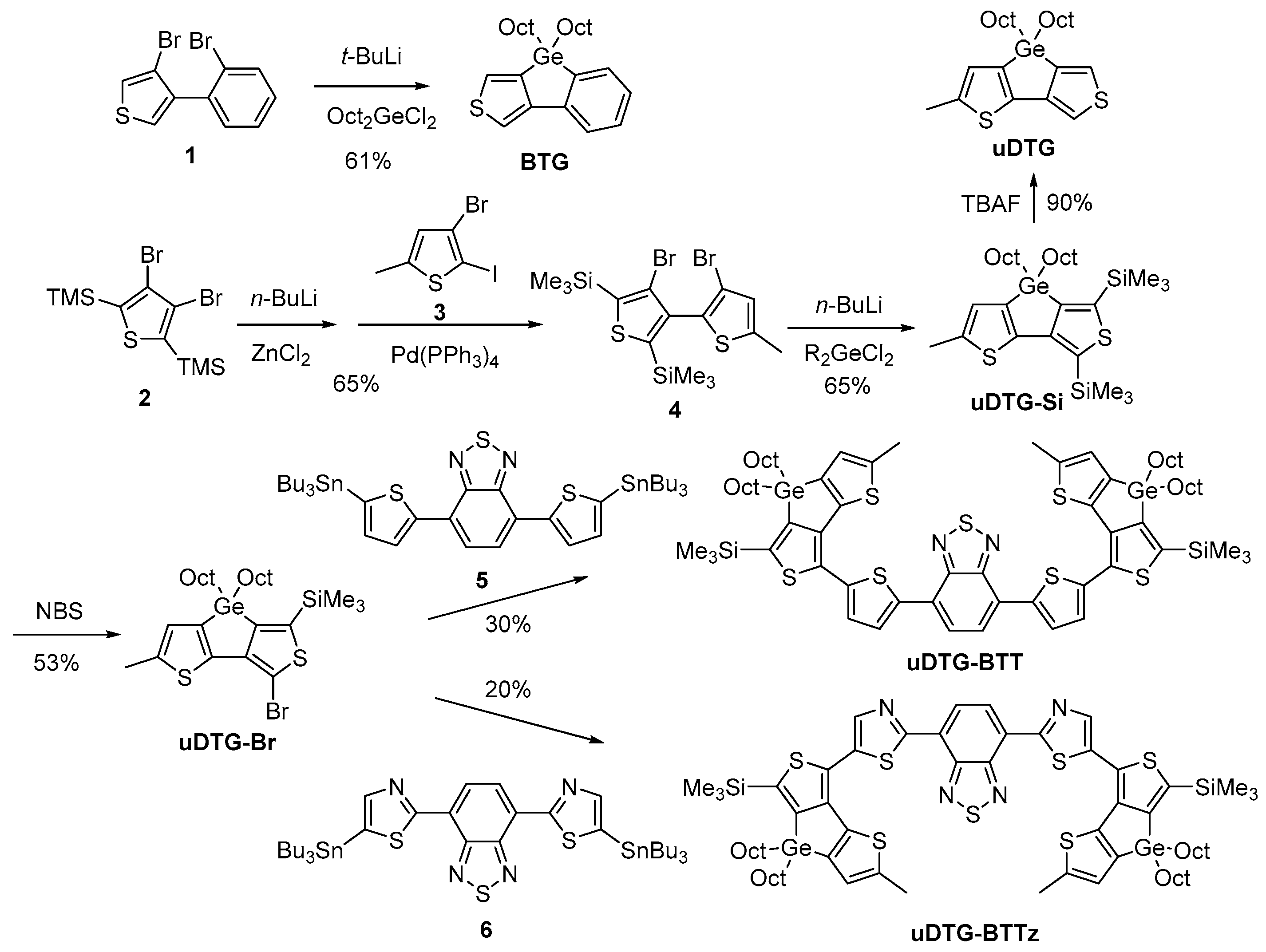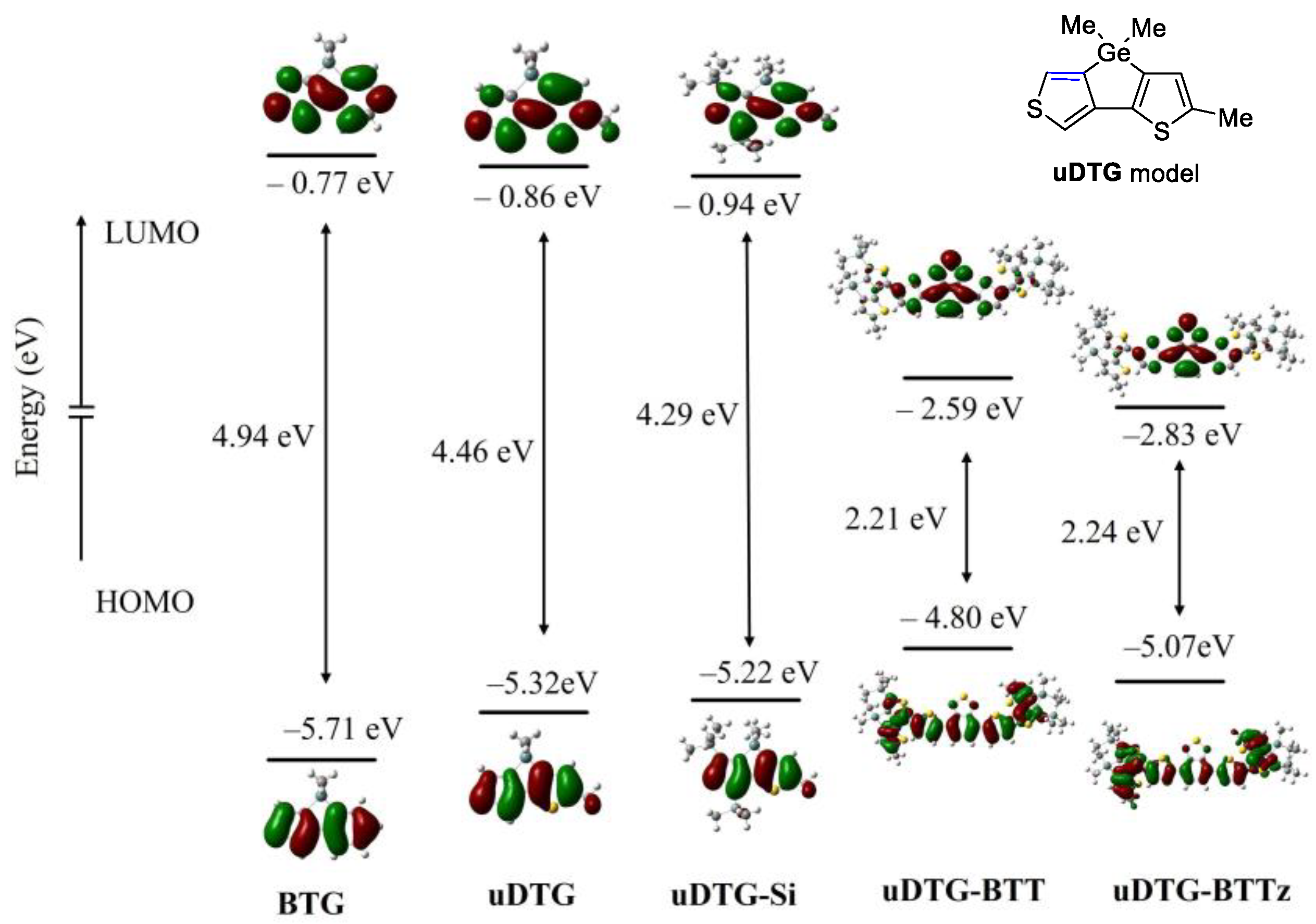The Preparation of Dithieno[3,2-b:4,5-c’]germole, and Its Application as a Donor Unit in Conjugated D–A Compounds
Abstract
:1. Introduction
2. Results and Discussion
2.1. Synthesis
2.2. Optical and Electrochemical Measurements
2.3. Quantum Chemical Calculations
3. Experimental Section
3.1. General Preparation
3.2. Procedures for Synthesis
3.2.1. Synthesis of BTG
3.2.2. Synthesis of 4
3.2.3. Synthesis of uDTG-Si
3.2.4. Synthesis of uDTG
3.2.5. Synthesis of uDTG-Br
3.2.6. Synthesis of uDTG-BTT
3.2.7. Synthesis of uDTG-BTTz
3.3. DFT Calculations
4. Conclusions
Supplementary Materials
Author Contributions
Funding
Institutional Review Board Statement
Informed Consent Statement
Data Availability Statement
Conflicts of Interest
References
- Baumgartner, T.; Jäkle, F. (Eds.) Main Group Strategies towards Functional Hybrid Materials; John Wiley & Sons: Hoboken, NJ, USA, 2018. [Google Scholar]
- Salzner, U.; Lagowski, J.B.; Pickup, P.G.; Poirier, R.A. Comparison of Geometries and Electronic Structures of Polyacetylene, Polyborole, Polycyclopentadiene, Polypyrrole, Polyfuran, Polysilole, Polyphosphole, Polythiophene, Polyselenophene and Polytellurophene. Synth. Met. 1998, 96, 177–189. [Google Scholar] [CrossRef]
- Ohshita, J. Conjugated Oligomers and Polymers Containing Dithienosilole Units. Macromol. Chem. Phys. 2009, 210, 1360–1370. [Google Scholar] [CrossRef]
- Zhang, Z.; Zhu, X. Dithienosilole-Based Non-fullerene Acceptors for Efficient Organic Photovoltaics. J. Mater. Chem. A 2018, 6, 4266–4270. [Google Scholar] [CrossRef]
- Zając, D.; Honisz, D.; Łapkowski, M.; Sołoducho, J. Synthesis and Properties of New Dithienosilole Derivatives as Luminescent Materials. Molecules 2019, 24, 2259. [Google Scholar] [CrossRef] [PubMed]
- Cai, Y.; Qin, A.; Tang, B.Z. Siloles in Optoelectronic Devices. J. Mater. Chem. C 2017, 5, 7375–7389. [Google Scholar] [CrossRef]
- Zhao, J.; Qiu, D.; Shi, J.; Wang, H. Synthesis of Dithieno[2,3-b:4’,3’-d]siloles and Their Selective Bromination. J. Org. Chem. 2012, 77, 2929–2934. [Google Scholar] [CrossRef] [PubMed]
- Liu, L.; Song, J.; Lu, H.; Wang, H.; Bo, Z. Novel Dithienosilole-Based Conjugated Copolymers and Their Application in Bulk Heterojunction Solar Cells. Polym. Chem. 2016, 7, 319–329. [Google Scholar] [CrossRef]
- Li, M.; Liu, L.; Zhao, C.; Zhou, Y.; Guo, Y.; Song, J.; Wang, H. Side Chain Engineering of Dithienosilole-Based Polymers for Application in Polymer Solar Cells. Dyes Pigm. 2016, 134, 480–486. [Google Scholar] [CrossRef]
- Guo, X.; Zhou, N.; Lou, S.J.; Hennek, J.W.; Ponce Ortiz, R.; Butler, M.R.; Marks, T.J. Bithiopheneimide–Dithienosilole/Dithienogermole Copolymers for Efficient Solar Cells: Information from Structure–Property–Device Performance Correlations and Comparison to Thieno[3,4-c]pyrrole-4,6-dione Analogues. J. Am. Chem. Soc. 2012, 134, 18427–18439. [Google Scholar] [CrossRef]
- Amb, C.M.; Chen, S.; Graham, K.R.; Subbiah, J.; Small, C.E.; So, F.; Reynolds, J.R. Dithienogermole as A Fused Electron Donor in Bulk Heterojunction Solar Cells. J. Am. Chem. Soc. 2011, 133, 10062–10065. [Google Scholar] [CrossRef]
- Ohshita, J.; Hwang, Y.M.; Mizumo, T.; Yoshida, H.; Ooyama, Y.; Harima, Y.; Kunugi, Y. Synthesis of Dithienogermole-Containing π-Conjugated Polymers and Applications to Photovoltaic Cells. Organometallics 2011, 30, 3233–3236. [Google Scholar] [CrossRef]
- Adachi, Y.; Nabeya, T.; Nomura, T.; Kondo, K.; Kawakami, K.; Ooyama, Y.; Ohshita, J. Direct Comparison of Dithienosilole and Dithienogermole as π-conjugated Linkers in Photosensitizers for Dye-Sensitized Solar Cells. Dalton Trans. 2019, 48, 16671–16678. [Google Scholar] [CrossRef] [PubMed]
- Adachi, Y.; Ooyama, Y.; Shibayama, N.; Ohshita, J. Synthesis of Organic Photosensitizers Containing Dithienogermole and Thiadiazolo[3,4-c]pyridine Units for Dye-sensitized Solar Cells. Dalton Trans. 2016, 45, 13817–13826. [Google Scholar] [CrossRef] [PubMed]
- Ohshita, J.; Sugino, M.; Ooyama, Y.; Adachi, Y. Synthesis of Pyridinothienogermoles as Unsymmetrically Condensed Germoles. Organometallics 2019, 38, 1606–1613. [Google Scholar] [CrossRef]
- Wang, C.H.; Adachi, Y.; Ohshita, J. Synthesis of Unsymmetrically Condensed Benzo-and Thienotriazologermoles. Molecules 2024, 29, 2684. [Google Scholar] [CrossRef] [PubMed]
- Pham, N.N.; Parpart, S.; Grigoryan, S.; Ngo, T.N.; Dang, T.T.; Ghochikyan, T.V.; Langer, P. Convenient Synthesis of Thieno[3,2-b]indoles and Thieno[3,4-b]indoles by Sequential Site-Selective Suzuki and Double C–N Coupling Reactions. Eur. J. Org. Chem. 2017, 2017, 538–550. [Google Scholar] [CrossRef]
- Ding, L.; Wang, Z.Y.; Yao, Z.F.; Liu, N.F.; Wang, X.Y.; Zhou, Y.Y.; Pei, J. Controllable Transformation between the Kinetically and Thermodynamically Stable Aggregates in a Solution of Conjugated Polymers. Macromolecules 2021, 54, 5815–5824. [Google Scholar] [CrossRef]
- Lin, Y.; Jiang, C.; Hu, F.; Yin, J.; Yu, G.A.; Liu, S.H. Synthesis, Characterization, and Properties of Some Bisacetylide and Binuclear Acetylide Gold(I) Compounds Based on the Photochromic Dithienylethene Unit. Dyes Pigm. 2013, 99, 995–1003. [Google Scholar] [CrossRef]
- Yabusaki, Y.; Ohshima, N.; Kondo, H.; Kusamoto, T.; Yamanoi, Y.; Nishihara, H. Versatile Synthesis of Blue Luminescent Siloles and Germoles and Hydrogen-Bond-Assisted Color Alteration. Chem. Eur. J. 2010, 19, 5581–5585. [Google Scholar] [CrossRef]
- Ohshita, J.; Nakamura, M.; Ooyama, Y. Preparation and Reactions of Dichlorodithienogermoles. Organometallics 2015, 34, 5609–5614. [Google Scholar] [CrossRef]
- Lee, K.H.; Ohshita, J.; Tanaka, D.; Tominaga, Y.; Kunai, A. Synthesis and Optical Properties of Spirobi(dithienometallole)s and Spirobi(dithienothiametalline)s. J. Organomet. Chem. 2012, 710, 53–58. [Google Scholar] [CrossRef]
- Barłóg, M.; Zhang, X.; Kulai, I.; Yang, D.S.; Sredojevic, D.N.; Sil, A.; Ji, X.; Salih, K.S.M.; Bazzi, H.S.; Bronstein, H.; et al. Indacenodithiazole-Ladder-Type Bridged Di (thiophene)-Difluoro-Benzothiadiazole-Conjugated Copolymers as Ambipolar Organic Field-Effect Transistors. Chem. Mater. 2019, 31, 9488–9496. [Google Scholar] [CrossRef]
- Sun, W.; Adachi, Y.; Ohshita, J. Synthesis of Thiazole-Condensed Germoles with Enhanced Electron-Deficient Properties. Dyes Pigm. 2022, 203, 110333. [Google Scholar] [CrossRef]
- Zhang, Y.; Song, J.; Qu, J.; Qian, P.-C.; Wong, W.-Y. Recent Progress of Electronic Materials Based on 2,1,3-Benzothiadiazole and Its Derivatives: Synthesis and Their Application in Organic Light-Emitting Diodes. Sci. China Chem. 2021, 64, 341–357. [Google Scholar] [CrossRef]
- Ong, K.H.; Lim, S.L.; Tan, H.S.; Wong, H.K.; Li, J.; Ma, Z.; Chen, Z.K. A Versatile Low Bandgap Polymer for Air-Stable, High-Mobility Field-Effect Transistors and Efficient Polymer Solar Cells. Adv. Mater. 2011, 11, 1409–1413. [Google Scholar] [CrossRef]
- Cao, Y.; Lei, T.; Yuan, J.; Wang, J.Y.; Pei, J. Dithiazolyl-Benzothiadiazole-Containing Polymer Acceptors: Synthesis, Characterization, and All-Polymer Solar Cells. Polym. Chem. 2013, 4, 5228–5236. [Google Scholar] [CrossRef]
- Frisch, M.J.; Trucks, G.W.; Schlegel, H.B.; Scuseria, G.E.; Robb, M.A.; Cheeseman, J.R.; Scalmani, G.; Barone, V.; Petersson, G.A.; Nakatsuji, H.; et al. Gaussian 16, Revision C.01; Gaussian, Inc.: Wallingford, CT, USA, 2019. [Google Scholar]
- Foresman, J.B.; Frisch, A. Exploring Chemistry with Electronic Structure Methods, 3rd ed.; Gaussian, Inc.: Wallingford, CT, USA, 2015. [Google Scholar]
- Pandey, N.; Tewari, N.; Pant, S.; Mehata, M.S. Solvatochromism and Estimation of Ground and Excited State Dipole Moments of 6-Aminoquinoline. Spectrochim. Acta A Mol. Biomol. Spectrosc. 2022, 267, 120498. [Google Scholar] [CrossRef]






| Compound | UV abs. λmax a/nm | PL λmax a,b/nm (Φf) | HOMO c/eV | LUMO d/eV | LUMO–HOMO e/eV |
|---|---|---|---|---|---|
| BTG | 280 | 323 (<2%) | −6.27 | −2.31 | 3.96 |
| uDTG | 303 | 347 (3.8%) | −5.50 | −1.73 | 3.77 |
| uDTG-Si | 315 | 360 (<2%) | −5.52 | −1.90 | 3.62 |
| uDTG-BTT | 329, 520 | 653 (33%) | −5.08 | −3.04 | 2.04 |
| uDTG-BTTz | 331, 501 | 634 (41%) | −5.16 | −3.05 | 2.11 |
Disclaimer/Publisher’s Note: The statements, opinions and data contained in all publications are solely those of the individual author(s) and contributor(s) and not of MDPI and/or the editor(s). MDPI and/or the editor(s) disclaim responsibility for any injury to people or property resulting from any ideas, methods, instructions or products referred to in the content. |
© 2024 by the authors. Licensee MDPI, Basel, Switzerland. This article is an open access article distributed under the terms and conditions of the Creative Commons Attribution (CC BY) license (https://creativecommons.org/licenses/by/4.0/).
Share and Cite
Wang, C.-H.; Adachi, Y.; Ohshita, J. The Preparation of Dithieno[3,2-b:4,5-c’]germole, and Its Application as a Donor Unit in Conjugated D–A Compounds. Molecules 2024, 29, 3553. https://doi.org/10.3390/molecules29153553
Wang C-H, Adachi Y, Ohshita J. The Preparation of Dithieno[3,2-b:4,5-c’]germole, and Its Application as a Donor Unit in Conjugated D–A Compounds. Molecules. 2024; 29(15):3553. https://doi.org/10.3390/molecules29153553
Chicago/Turabian StyleWang, Cong-Huan, Yohei Adachi, and Joji Ohshita. 2024. "The Preparation of Dithieno[3,2-b:4,5-c’]germole, and Its Application as a Donor Unit in Conjugated D–A Compounds" Molecules 29, no. 15: 3553. https://doi.org/10.3390/molecules29153553





